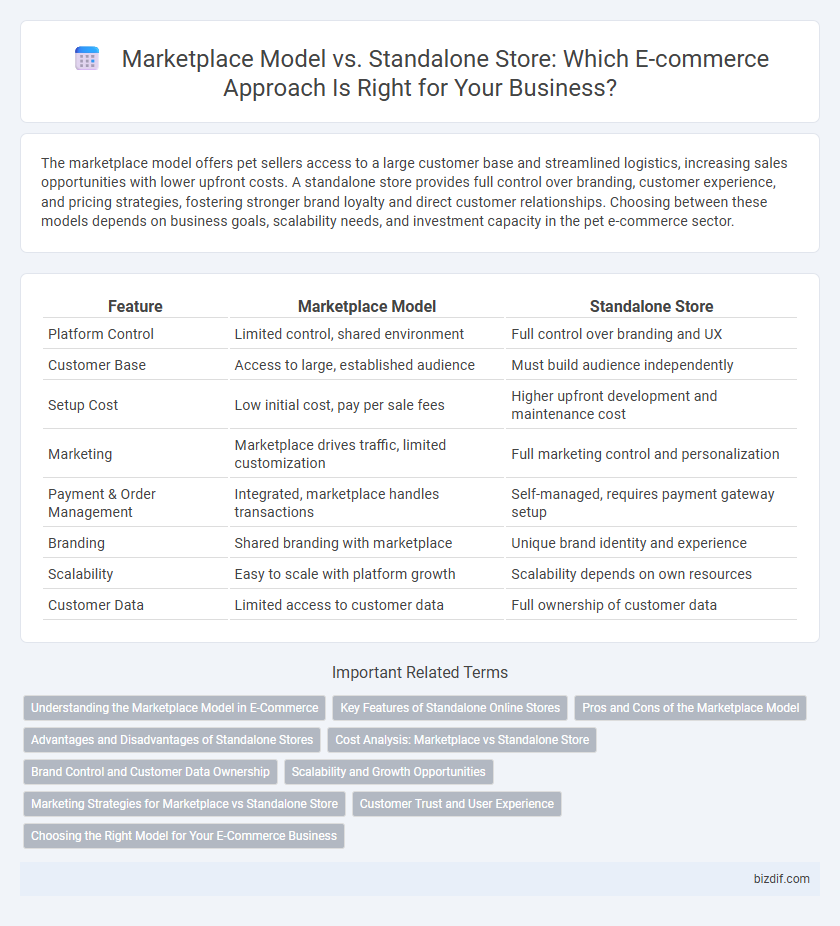The marketplace model offers pet sellers access to a large customer base and streamlined logistics, increasing sales opportunities with lower upfront costs. A standalone store provides full control over branding, customer experience, and pricing strategies, fostering stronger brand loyalty and direct customer relationships. Choosing between these models depends on business goals, scalability needs, and investment capacity in the pet e-commerce sector.
Table of Comparison
| Feature | Marketplace Model | Standalone Store |
|---|---|---|
| Platform Control | Limited control, shared environment | Full control over branding and UX |
| Customer Base | Access to large, established audience | Must build audience independently |
| Setup Cost | Low initial cost, pay per sale fees | Higher upfront development and maintenance cost |
| Marketing | Marketplace drives traffic, limited customization | Full marketing control and personalization |
| Payment & Order Management | Integrated, marketplace handles transactions | Self-managed, requires payment gateway setup |
| Branding | Shared branding with marketplace | Unique brand identity and experience |
| Scalability | Easy to scale with platform growth | Scalability depends on own resources |
| Customer Data | Limited access to customer data | Full ownership of customer data |
Understanding the Marketplace Model in E-Commerce
The marketplace model in e-commerce allows multiple third-party sellers to list and sell products on a single platform, leveraging shared infrastructure, customer base, and payment systems. This model offers businesses reduced overhead costs and increased exposure compared to standalone stores, which require independent site management and marketing efforts. Understanding the marketplace model highlights its scalability and access to a diverse customer pool, making it an efficient choice for sellers aiming to expand without significant investment in technology and logistics.
Key Features of Standalone Online Stores
Standalone online stores offer complete control over branding, user experience, and customer data, enabling businesses to create a unique identity tailored to their target audience. They provide flexibility in inventory management, marketing strategies, and pricing without the restrictions imposed by third-party marketplaces. Enhanced customization options and direct customer relationships drive higher profit margins and foster long-term brand loyalty.
Pros and Cons of the Marketplace Model
The marketplace model offers access to a large customer base and lower upfront costs, enabling sellers to scale quickly without significant marketing investment. However, it involves higher competition, limited brand control, and reliance on platform policies that can change unexpectedly. Sellers face fees and reduced profit margins compared to standalone stores, which impact overall revenue potential.
Advantages and Disadvantages of Standalone Stores
Standalone stores offer complete control over branding, customer experience, and data management, enabling businesses to create a unique and personalized shopping environment. However, they require significant investment in website development, marketing, and traffic generation, which can be costly and time-consuming compared to marketplaces. Limited built-in audience reach and slower customer acquisition represent key challenges for standalone e-commerce stores.
Cost Analysis: Marketplace vs Standalone Store
Marketplace models reduce upfront costs by eliminating the need for website development, maintenance, and marketing expenses, benefiting sellers with limited budgets. Standalone stores require significant investment in web design, hosting, and platform management but offer greater control over branding and customer data. While marketplaces charge commission fees and listing costs, standalone stores incur fixed monthly fees plus payment processing expenses, making the total cost dependent on sales volume and business scale.
Brand Control and Customer Data Ownership
Marketplace models limit brand control as sellers must adhere to platform policies, reducing customization opportunities and direct customer engagement. Standalone stores offer full brand control, enabling personalized customer experiences and tailored marketing strategies. Ownership of customer data in standalone stores empowers brands to analyze behavior, optimize retention, and drive targeted sales campaigns.
Scalability and Growth Opportunities
Marketplace models offer significant scalability by providing access to a broad customer base and leveraging shared infrastructure, which reduces operational costs and accelerates growth opportunities. Standalone stores demand substantial investment in marketing, technology, and logistics but allow full control over brand experience and customer data, supporting targeted scaling strategies. Businesses prioritizing rapid market penetration often prefer marketplaces, while those focused on brand differentiation and long-term customer loyalty benefit from standalone e-commerce stores.
Marketing Strategies for Marketplace vs Standalone Store
Marketplace models leverage extensive user bases and collective seller data to optimize targeted advertising and promotions, enhancing visibility through platform-wide campaigns and built-in SEO advantages. Standalone stores require focused, brand-specific marketing strategies, utilizing personalized content, social media engagement, and paid advertising to drive traffic and establish unique customer loyalty. Data analytics in marketplaces prioritize competitive pricing and product diversity, while standalone stores emphasize customer experience and direct communication to maximize conversion and retention.
Customer Trust and User Experience
Marketplace models enhance customer trust by offering diverse product options and verified seller reviews, creating a reliable shopping environment. Standalone stores provide a tailored user experience with brand-specific design and direct customer support, fostering loyalty through personalized interactions. Both models impact trust and usability differently, with marketplaces benefiting from social proof and standalone stores excelling in customized engagement.
Choosing the Right Model for Your E-Commerce Business
Choosing the right e-commerce model depends on factors like target audience reach, control over branding, and operational costs. Marketplace models offer access to large customer bases with lower upfront investment, while standalone stores provide full brand control and the ability to customize customer experience. Evaluating product type, budget, and long-term growth goals is essential to determine the ideal approach for sustainable e-commerce success.
Marketplace Model vs Standalone Store Infographic

 bizdif.com
bizdif.com